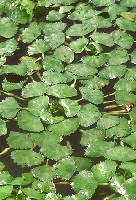| DESCRIPTION: It is a annual, vascular plant floating freely or rooting in the mud. It can also produce land forms on wet mud substrates. It has floating fan-shaped leaves clustered toward the tip of the stem forming a single rosette. These leaves have long petioles with an inflated spongy region which enables the plant to float. It has small, solitary, 4-petalled and white flowers. USE: Its fruit and seed can be eaten raw, cooked, or dried and ground into flour. Used also as food for pigs and other livestock in southeast Asia. Fruits are used in the preparation of liniments to treat elephantiasis, pestilent fevers, rheumatism, sores, sunburn and skin complaints. Used as an ornamental in garden ponds and in big aquariums. GROWING PERIOD: Annual. COMMON NAMES: Water chestnut, Water nut, Bull nut, Vassnøtt, Hornnød. FURTHER INF: Usually found in water up to 60 cm deep primarily in protected portions of slow-flowing rivers, lakes, ponds, and canals. However, it can also be found in waters to a depth of 5 m. They are easily moved about by wind or water currents and can cover a large area of water. It is native of western Asia (Malaysia, India and China and the Mediterranean and found in most of Europe into southern Scandinavia and the Caucusus and Siberia. Also found in northern Africa and the north-eastern United States and adjacent Canada. |
